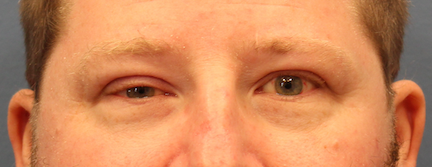Conditions: Horner’s Syndrome
What is Horner’s syndrome?
Horner's syndrome is a nerve disorder caused by dysfunction of nerves in the sympathetic chain of the neck, and is characterized by a triad of symptoms, First, there is drooping of the upper eyelid (ptosis), which occurs due to the partial paralysis of the muscles responsible for lifting the eyelid. Second, there is miosis, which is the constriction of the pupil on the affected side. This happens because of the disruption of the sympathetic nervous system that controls the dilation of the pupil. Lastly, there is anhidrosis, or decreased sweating, particularly on the affected side of the face, and decreased tear formation from the lacrimal gland on the affected side. The degree of each of these symptoms may vary from one affected individual to the next, and over time. Horner's syndrome can be caused by various underlying conditions such as a stroke, tumor, injury, or certain neurological diseases. Treatment of Horner's syndrome focuses on addressing the underlying condition and managing any associated symptoms to improve the patient's quality of life.
What does horner’s syndrome look like?
Artist’s depiction of right eye Horner’s syndrome, with ptosis of the right eyelid and constriction of the pupil (miosis),
Horner’s syndrome of the patient’s right eye.
Horner’s syndrome of the patient’s right eye.
what is the sympathetic chain?
The sympathetic chain, also known as the sympathetic trunk, is a crucial component of the autonomic nervous system responsible for the body's fight-or-flight response. This chain of ganglia (enlargements of nerves) runs along both sides of the vertebral column, connecting to spinal nerves through which it communicates with various organs and tissues. The sympathetic chain plays a vital role in regulating key bodily functions such as heart rate, blood pressure, and respiratory rate in response to stress or danger. The portion of the sympathetic chain affected in Horner’s syndrome is high (superior) in the neck.
What causes horner’s syndrome? Or, how does the superior sympathetic chain become dysfunctional?
The underlying causes of Horner's syndrome are varied and may include compression or invasion by a tumor, by traumatic injuries, such as car accidents or falls, Riedel’s thyroiditis, conditions affecting the sympathetic nerves, such as tumors in the neck or chest, stroke, syphilis, multiple sclerosis or other neurological diseases. Additionally, surgery in the neck or chest area, certain medications, or even migraines can also lead to the development of Horner's syndrome.
Why can the sympathetic trunk affected by surgery?
During surgery, there is a possibility that the sympathetic trunk may be affected due to its close proximity to the surgical dissection or the need to remove tissue that contains sympathetic trunk nerve fibers. Surgical manipulation, particularly in areas near the spine, can inadvertently stretch, disrupt or damage the nerve fibers of the sympathetic trunk. The interconnected web of nerve fibers contributing to the sympathetic trunk are not always large enough to be visible and distinctly identifiable. In the case of tumor surgery, removing the tumor completely may require removal of some nearby nerve-containing tissue. Further, if tumor were in proximity to the sympathetic trunk, additional growth of the tumor may cause Horner’s syndrome.
Does horner’s syndrome improve over time?
The prognosis for Horner's syndrome can vary depending on its underlying cause. In some cases, such as post-surgical or post-traumatic cases, the symptoms may improve gradually over time as the damaged nerves heal. However, if Horner's syndrome is caused by an underlying medical condition, such as a tumor, the symptoms may persist or worsen unless the underlying cause is treated. For this reason, it is important for an individual with Horner's syndrome to consult with their physician to determine the underlying cause and appropriate treatment options.
How can Horner’s syndrome be treated?
Treatments of Horner’s syndrome may be grouped into two categories. First, restoring some or all normal neurologic function of the sympathetic trunk, if possible, is ideal. This may be a matter of relieving pressure from the sympathetic trunk or allowing time for the sympathetic trunk to heal after injury. The second category of treating Horner’s syndrome treats the symptoms or downstream consequences rather than the cause itself. This may include using artificial tears to treat the eye dryness and a medicine to facilitate elevating the droopy upper eyelid (such as apraclonidine ophthalmic solution 0.5% or oxymetazoline hydrochloride ophthalmic solution 0.1%, 1 drop daily if needed). Surgery of the eyelid may be undertaken to shorten or repair the affected eyelid muscle responsible for elevating the upper eyelid, the levator palpebral superioris. Treatment should be undertaken after thorough evaluation for an underlying cause.






